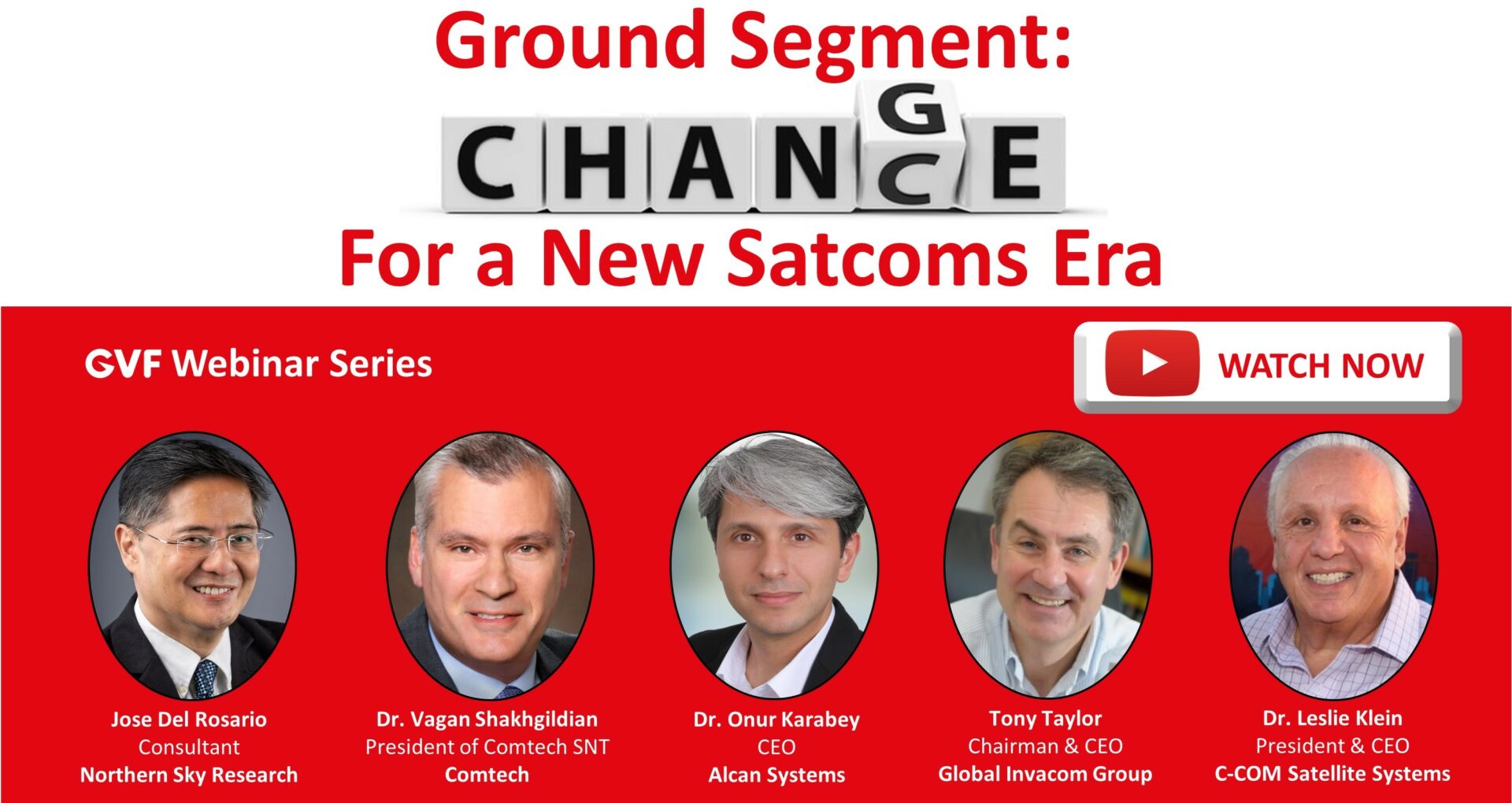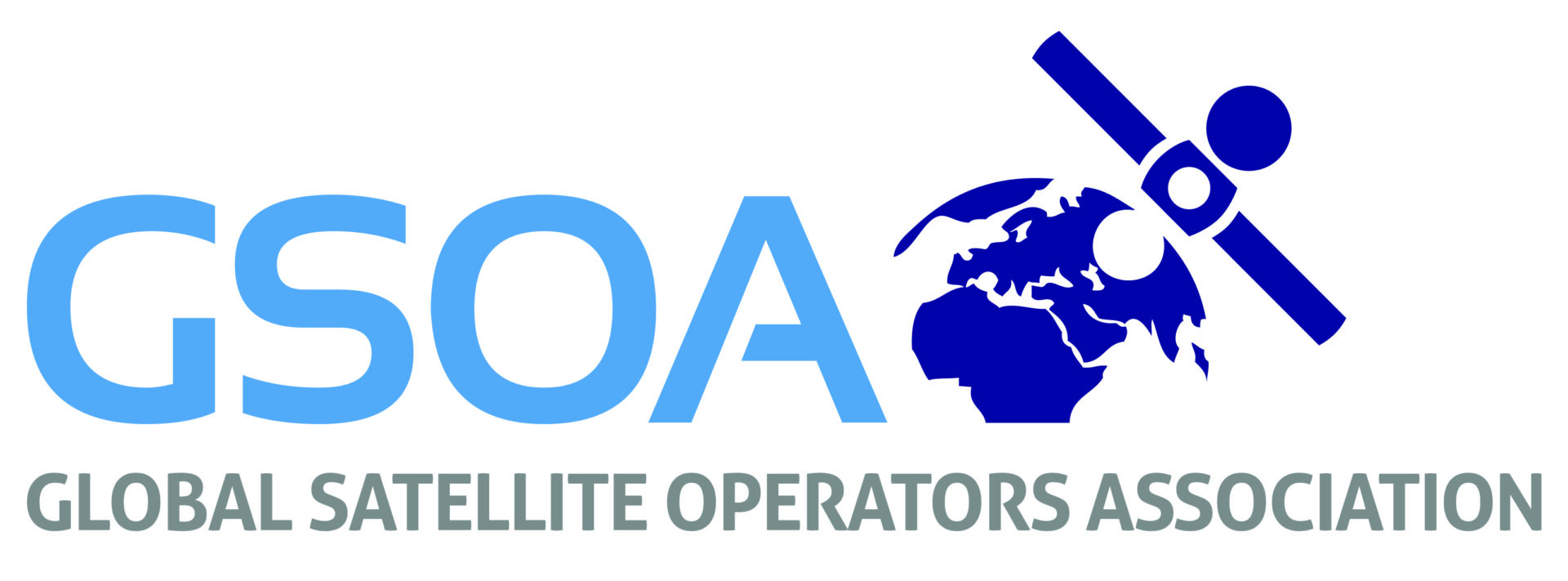Ground Segment: All Change for a New Satcoms Era

In this latest event in the programme of GVF webinars we continued our long-standing series examination of the satellite communications ground segment. Anyone who views the ground segment as the less interesting twin to the satellites was disabused by the the expressions of bullish enthusiasm of today’s panel the number of audience members, and the wealth of audience generated questions.
During almost 75-minutes of lively discussion our panel of distinguished ground segment representatives – from Alcan Systems, C-COM Satellite Systems, Comtech Satellite Network Technologies, and Global Invacom Group – provided an authoritative justification for the introduction of the concept of “New Ground” to parallel and complement New Space.
Today’s dialogue brought a greatly enhanced clarity to understanding the nature of the profound changes which the ground segment is undergoing across such topics as AI, virtualisation and software-defined networks, standardisation, and use of higher frequencies.
For the many audience questions for which even 75-minutes provided insufficient time, you will find panellist’s responses here. We hope you enjoy the recording and gain from its insights into the causalities of developments, back and forth, between space and ground segments.
Q & A continued….
The following question was posed through the chat function during the panel but we ran out of time to respond in the live programme. Thank you to our audience for taking an active part by asking questions, and to our panellists for their time to answer them after the webinar ended…
1. What the average cost per terminal (customer side equipment) expected for the new LEO/MEO constellations. Do you think the new satellite constellations and planned huge capacity that will be added “to the market”? Will it be mainly oriented to the end customers (so low cost per CPE is mandatory) or it will be a classic market B2B layout where local service providers and MNO (Mobile Network Operators) will be still the main customers of the satellite capacity? Thank you!
Leslie Klein (C-COM): We at C-COM are focusing on replacing COTP mechanical terminals with COTM Phased Array terminals that will be useable on GEO, LEO and MEO and be able to be used for Aero, Marine and Terrestrial in motion uses. These will commercial units and will be in excess of $25-30K per terminal.
Vagan Shakhgildian (Comtech): We cannot name one price /cost for all terminals in all constellations. Some constellations intend to focus on B2B as you stated, others announced consumer broadband as their target market. Satellite consumer broadband has been successful in North America; we will see to what extent this success can be reproduced elsewhere. So far the global trend has been that many of the emerging satellite systems end up focusing on the classic B2B market that you mention.
Tony Taylor (Global Invacom Group): As I said online, we at Global Invacom Group (GIG) are aiming at $100’s rather than $1000’s of dollars. I cannot put a more exact figure on it today (watch this space) no pun intended. Telecom data backhaul is a huge part of the market today, I don’t see that changing as mobile data growth is growing exponentially, but their ability to be more focused on the service they use, i.e. messaging and data can still be on GEO if it’s the cheapest option because the user cannot tell. Voice probably LEO or MEO etc. Personally I see LEO as ideal for autonomous control, military, stock trading and gambling and those that can afford the fastest and best, just because they can.
Onur Karabey (ALCAN): We at ALCAN are focusing on enterprise, consumer and land mobile markets. We will offer a low-cost antenna, which can be useable for Ka-band NGSO satellites. The cost of enterprise antenna will be €1500. The cost of consumer and land mobile antennas will be less since the antenna will be smaller and volume will be higher. Stay tuned.
2. What is your prognosis of market and communications over GEO satellites assuming explosive development of LEO communications? Will GEO communications transfer to LEO satellites or GEO market will continue to grow?
Leslie Klein (C-COM): GEO customers will unlikely to move to LEO unless they need full mobility and much more bandwidth than they use today. That market will continue to exists as long as GEO satellites are going to be launched.
Onur Karabey (ALCAN): GEO operators will push hard to keep their positions. Eventually, their existence or market share will depend on success of LEO operators. As discussed yesterday, cost of ground terminal is the key point for the LEO operators. In other words, existence of low cost ground terminals will impact market share of GEO operators dramatically.
Tony Taylor (Global Invacom Group): I expect the traditional GEO suppliers to come out fighting on cost, service and reliability. Hughes and Viasat etc are not going to sit idly by waiting for Starlink to take all the business. Once Jupiter 3 and Viasat 3 are launched expect action. Right now they are both (H&V) full to capacity.
Vagan Shakhgildian (Comtech): The CEO satcom systems will continue to grow while evolving in several directions: VHTS with super-high throughput beams for global systems, Smallsat for regional /national needs.
3. I am aware of the potential for transitional use of aerostat systems as a last mile connection to a broad service area that can enable the use of low-cost user terminals. By low cost most certainly well below $300 target price stated during your discussions.
Leslie Klein (C-COM): Check out the links shown in 4. Below. This solution would enable a 5 or 6G phone to be utilised as a terminal.
4. Have any of the panelists awareness of aerostat use as infrastructure for last mile connectivity?
Vagan Shakhgildian (Comtech): The CEO satcom systems will continue to grow while evolving in several directions: VHTS with super-high throughput beams for global systems, Smallsat for regional /national needs.
Leslie Klein (C-COM): You may be interested to read these about HAPS Mobile and C-COM.
5. When considering 5G then when will the satellite industry finally step up and develop the technology to deliver a role in 5G?
Vagan Shakhgildian (Comtech): Satellite will certainly play a role in 5G. if only in the traditional backhaul application. However more possibilities are open by further synergy of satellite and terrestrial 5G in terms of the overall network architecture and even air interface /waveforms. This is being actively pursued on by several parties.
Tony Taylor (Global Invacom Group): When and if the telecom industry let’s them in! We will continue to have a role in data backhaul whatever.
Onur Karabey (ALCAN): See a technical document from Ericsson. As Tony mentioned Telco operators should except satellite operators. This has started: BT & OneWeb or Verizon & Amazon. We need to deliver ground terminals which can work with both infrastructures
Leslie Klein (C-COM): Check out this upcoming technology C-COM is partnering with.
6. Why are we not talking about 5G Broadcast? That is a serious role for Satellite…
Tony Taylor (Global Invacom Group): True but only if the Telecom industry is willing to let us join the party.
Onur Karabey (ALCAN): Broadcast becomes subset of broadband as long as you have affordable and reliable link.
Leslie Klein (C-COM): It will just continue with both legacy and new constellations. The antennas will make it possible to deliver 5G economically.
Vagan Shakhgildian (Comtech): This is being discussed in the context of offloading of 5G video broadcast to satellite links.
7. After the announcement of new policy now the private players can play a role in Indian Market.
Leslie Klein (C-COM): C-COM is looking to work with integrators and Resellers in India. We would love to sell 20,000 mobile banking units to the banks in India. We have a few hundred of these already deployed all over the world.
8. Are you sure that the market has the stomach for absorbing these failures?
Leslie Klein (C-COM): Absolutely. Look at OneWeb which just went bankrupt. It was sold at half price of what was invested into it. A good deal for sure.
Onur Karabey (ALCAN): Yes. However, this will not happen with pleasure. Due to demand for high-speed connectivity anytime anywhere, a solution will be found. All speakers agreed that it is not easy but right to address since funds are available and new technologies are in pipeline.
Tony Taylor (Global Invacom Group): With the level of WW interest currently and the money available in the markets today, Yes, but not sure of the length of the timescale.
Vagan Shakhgildian (Comtech): No one can be sure. And a major failure is likely to deliver a blow to the appetite of investors for space /satellite industry. That said, the markets absorbed failures in the past. The recent string of Chapter 11 filings is one example.
9. What will happen to the orbital highway if the bankrupted systems satellites are left in orbit and remain unmanaged? We are already close to Kessler (if not already there)…
Tony Taylor (Global Invacom Group): Without maintenance I would expect LEO and MEO sat’s to re-enter earth’s orbit and burn up as Motorola planned for the original Iridium constellation. If we take Iridium as a guide, governments will get involved, in the case of Iridium it was the U.S.
Vagan Shakhgildian (Comtech): My understanding is that obligations to deal with such situations (i.e. clean-up/de-orbiting) may be written into the operators statute.
Leslie Klein (C-COM): Satellite operators are responsible to manage the satellites they launched. If they go bankrupt someone will take over this responsibility at a few pennies on a dollar. It has happened before and will happen again.
10. Appreciate the discussions, and the new paradigm- We are working with an innovate, edge caching company, Mo-DV, and envision at the edge opportunities within the Satellite-Satellites and Satellite-Ground ecosystem- is there a good contact information, for us to share more information?
GVF: Thank you for a truly interactive discussion today. If you wish to find out more, please contact our panellist companies directly:
Alcan Systems – [email protected]
